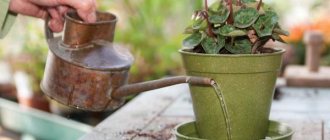Succinic acid for plants: benefits and harm, how does it affect plants?
This acid helps increase yield. This organic fertilizer is popular among those who grow indoor plants. The acid is well absorbed by plants, and its excess is broken down by microorganisms.
Benefit:
- Increases chlorophyll synthesis
- Stimulates plant growth
- Increases yield
- Strengthens roots
- Increases seed germination
- Improves the absorption of nutrients from the soil
There is no harm if the product is administered correctly. Basically, harm occurs when acid levels are regularly exceeded.
Succinic acid for plants: benefits and harm, how does it affect plants?
A few final tips
- The main difficulty of wick irrigation is to ensure the required level of water supply. Therefore, during the first days, watch the plant on the wick, check the condition of the soil and, if necessary, adjust the dose of moisture.
- Before transferring the plant to the wick, check whether it needs periods of complete drying of the soil, otherwise the root system may not be able to cope with the constant supply of moisture.
- Before switching a plant to wick watering, think about whether this is necessary. If there are only a few moisture-loving plants in the collection, you can probably get by with regular regular moistening. Any transplant is stressful for the home flora.
Sources
- https://MoiOrhidei.ru/fialki/fitilny-poliv
- https://GusiYabloni.com/sadogorod/cvetovodstvo/fitilnyj-poliv-rastenij-kak-sdelat.html
- https://rusfermer.net/sad/tsvetochnyj-sad/vyrashhivanie-tsvetov/fitilnyj-metod-poliva-fialok.html
- https://LePlants.ru/tsvetovodstvo/vse-chto-nuzhno-znat-o-fitilnom-polive-komnatnyh-rasteniy/
- https://superarch.ru/usadba/posadki/gorshok-s-fitilnyim-polivom
- https://komnatnie.com/fialki/uhod-fialki/poliv-uhod-fialki/fitilnyj.html
- https://ogorod.plus/fitilnyiy-poliv-fialok/
- https://komnatnie.com/fialki/uhod-fialki/poliv-uhod-fialki
- https://zelenj.ru/uhod-za-fialkoy.html
- https://pocvetam.ru/komnatnye-rasteniya/tsvetushchie/fitilniy-poliv-fialok-kak-sdelat.html
Soaking tomato and cucumber seeds for seedlings in succinic acid: instructions
This manipulation improves the similarity of the seeds.
Instructions:
- Dissolve 2 acid tablets in a liter of water until the crystals disappear
- After this, pour the seeds onto a saucer and fill with the prepared liquid.
- Soak the seed in the solution for a day. Drain the solution
- Place the seeds on a napkin and let dry completely
- You can sow
Soaking tomato and cucumber seeds for seedlings in succinic acid: instructions
Conditions of detention
After buying a violet in a store, leave it for 2 months isolated from other plants in the house to avoid the transmission of possible diseases or parasites. If not a separate room, then at least a place distant from the flower garden would be suitable. If you bought a violet from a private grower you trust, then you can choose a permanent place for it right away. The table presents recommended and non-recommended requirements for keeping violets at home.
| Violets love... | Violets do NOT like... |
| Lots of sunshine | Direct sunlight, especially at midday - leaves can get burned |
| Daylight hours are about 13 hours and additional illumination with phytolamps in winter (only under this condition will violets bloom in the cold season) | Drafts and sudden temperature changes. For this reason, it is better not to place violets on an open balcony in the summer. |
| Room temperature is about 24 degrees or slightly lower in winter | Cool air below 15 degrees. In such a climate, violets stop growing and blooming. |
| High air humidity | Drops of water on leaves and flowers. Therefore, Saintpaulias do not need spraying |
The blooming of homemade violets greatly decorates the windowsills. And due to the fact that Saintpaulias are usually small in size, this plays into the hands of owners of small apartments.
In summer, it is not advisable to place violets on an open balcony, since they do not tolerate temperature changes at night very well. But on the loggia (see photo below), where the temperature does not drop below 15 degrees, violets will feel good.
If you want violets to bloom in winter, provide them with additional lighting with LED or phyto lamps.
The use of succinic acid for growing seedlings as a growth stimulant: instructions
The frequency substance is used as a growth stimulant. To do this, the roots are kept in an acid solution for 1 day before planting the seedlings. After this, the seedlings are planted. Next, you need to spray. It is carried out every two weeks using a sprayer. You need to spray the leaves and stems.
The use of succinic acid for growing seedlings as a growth stimulant: instructions
Preparing the nutrient solution
In order for amber fertilizer to bring more benefits, it is necessary to maintain the proportions. The best solution for violets is considered to be 0.02%.
How to prepare: dissolve 1 g of acid in 50 ml of warm water. Then add 2 liters. Even if you exceed the concentration, it’s okay, it won’t harm the plants.
Important! Watering with an amber solution will not replace fertilizing with other fertilizers. Typically, an acid solution is used once every two to three weeks.
The use of succinic acid for growing tomatoes, cucumbers, potatoes and other vegetables in the garden
Most often, succinic acid is used in the garden as a growth stimulant rather than as a fertilizer. With its help you can increase the similarity of seeds. This reagent can be used to treat potato tubers.
Application in the garden:
- Processing cucumber and tomato seeds. It is necessary to pour a 0.01% solution into the seeds and leave for a day. After this, they are dried and sown.
- Tuber processing. Potato tubers for planting are moistened with a solution of succinic acid and covered with film. The planting material is kept for 2 hours, and then planted. Such manipulations improve flowering and stimulate seedling growth.
- Watering and spraying with a solution of a higher concentration will help to revive a painful, dying plant. For 1 liter of warm water, take 0.25 g of the drug.
The use of succinic acid for growing tomatoes, cucumbers, potatoes and other vegetables in the garden
Processing methods
Amber can be used for various purposes. It is suitable not only for watering or spraying plants.
Amber is used for spraying garlic or treating it before planting in the soil.
Main uses:
- Watering. This is done using a special watering can or a small mug/glass. You can apply the drug only at the root, avoiding drops on leaves or flowers.
- Soaking the roots. It is performed before planting seedlings into the ground, as well as, if necessary, to resuscitate a dying plant. In the first case, it is enough to hold the roots of the crop for a few minutes, then plant it in the soil. When using the drug for medicinal purposes, the course of procedures is longer (see above).
- Wiping leaves. This method of using Yantarine is more suitable for treating indoor plants. A cotton pad is moistened in the solution prepared according to the instructions, after which each leaf is wiped separately. Direction - from base to top. You need to process on both sides, gradually increasing the pressure. As a result, the last drops of the product should drain from the surface of the leaves.
- Spraying. Performed according to the sheet. During the procedure, you need to carefully process the leaves and stems of the plant.
Important! After using the solution to resuscitate plants, you must wait until their permanent flowering is established. And only after this is it possible to transplant them into a pot or artificial substrate.
Succinic acid for plants: reviews
This is a fairly common drug. It can be found at pharmacies and flower shops. You can buy acid in powder or tablets.
Reviews:
Oksana, 42 years old. I love indoor plants. I have a lot of violets and cacti. On the advice of the seller, I purchased the substance in tablets at a flower shop. She watered it and sprayed the stems and leaves with the remainder of the solution. After a week I noticed results. New shoots appeared on the rose, and the violets threw out their buds.
Elena, 34 years old. I use succinic acid to soak seeds. Of course, I don’t really like the procedure, since after soaking in the solution, the seeds need to be dried for several days and stirred frequently so that they do not become moldy. But I like the result. Even capricious peppers sprout.
Veronica, 24 years old. I have recently grown flowers. My collection is growing thanks to my work colleagues. For all the holidays they give me indoor plants. I bought complex fertilizer and succinic acid. I was very impressed with the result. The plants really came to life, many new branches appeared. Now I water and spray once a month.
Succinic acid for plants: reviews
Succinic acid is an inexpensive and effective means for stimulating crop growth. It is also a safe substance used against parasites.
Ready-made fertilizers for violet flowering
Organic fertilizers
In specialized stores you can buy special fertilizers based on humic acids, which are sold in bottles. They enhance the effect of mineral fertilizers and improve the condition of the soil, which is simply necessary for Saintpaulias to bloom. Use them according to the instructions written on the bottle.
You will be interested to know: When, what and how to water hydrogen peroxide in the garden and garden at the dacha
Superphosphate
The fertilizer will be an excellent stimulator of flowering and will acidify the soil (violets need slightly acidic soil). Superphosphate contains nitrogen and phosphorus. The first element is necessary for foliage growth, and the second for flowering.
Powder or granules are applied to the ground in dry form at the rate of 1 tsp per liter of soil. When watering, the granules will dissolve and saturate the soil with nutrients.
Complex mineral fertilizers
For lush and long-lasting flowering, violets need potassium and phosphorus. If the fertilizer contains more nitrogen, only the foliage on the bush will be lush.
It is best to purchase special fertilizer for violets, using it strictly according to the instructions written on the bottle or packaging. When choosing, pay attention to the composition. From spring to autumn, in order for Saintpaulia to bloom profusely, choose fertilizers that contain more potassium, phosphorus and less nitrogen.
Fertilizers should be applied correctly and strictly according to the instructions. A day before fertilizing, water the violets with plain water so that the fertilizer does not burn the roots of the flower.
What should the pot be like?
As mentioned above, violets develop better in small pots, receiving nutrition not from the soil, but from the solution.
A pot diameter of 5 to 8 cm is enough to get a beautifully formed rosette with a large head of flowers.
To avoid the accumulation of harmful impurities in small quantities of the substrate, violets must be replanted once every six months.
Soil selection
Regular soil used for growing plants is too heavy for violets and absorbs a lot of water, causing it to become compacted and sour.
When using wick irrigation, the soil should be loose and breathable. A baking powder (river sand, vermiculite, perlite) is placed in the pots along with peat - the soil is completely excluded.
The soil may consist of:
- store-bought soil for violets + pressed coconut peat + perlite or vermiculite - all in equal proportions;
- coconut peat + perlite or vermiculite - in equal proportions;
- soil for violets + perlite + vermiculite.
To prevent molding of the substrate, phytosporin is added. But if the proportions are violated and the conditions for keeping violets are not met, then phytosporin will not help.
Coco peat needs to be washed as it contains a large amount of salts. You need to wash it several times.
Wick or cord
A synthetic cord is used as a wick, since natural material undergoes rapid rotting.
The cord must have good water absorption.
The thickness of the cord is selected experimentally. Typically, for a pot with a diameter of 5 to 8 cm, a cord thickness of 0.5 cm is used.
When using wicks from nylon stockings or tights, the soil becomes soaked due to too much water absorption.
Peculiarities
This beauty needs careful care. Born in the Ulugur and Uzambara mountains of Tanzania, where warmth and moisture reign, in local latitudes it does not live in open spaces. When growing indoors, it requires certain knowledge and skills.
It does not cause allergies and blooms without smell. Being in a children's room will not provoke an exacerbation of the disease in an allergy or asthma sufferer. Releases phytoncides that kill and inhibit the growth of pathogenic bacteria. With proper care it blooms 10 months a year.
It is often confused with flowers of the violet family called Pansies, which grow in gardens and forests. They are unpretentious and grow well in northern regions, continental climates, tropics and subtropics, at high altitudes in mountains and river valleys. A native of Africa, Saintpaulia, has no family ties with them.
What kind of water is suitable
For humidification, soft water, two degrees above room temperature, is suitable. This flower should not be watered with a cold solution. Using rainfall or melting snow is impractical and harmful. The ecology of many cities and regions is not always suitable for this. Most of the elements from the periodic table end up on the continent with atmospheric phenomena, and not the most useful ones.
Centralized water supply to homes is produced with increased levels of calcium, magnesium, and sulfate bicarbonates. The water becomes hard and leaches the soil. The earth is changing its chemical composition. From slightly acidic, favorable for violets, it becomes neutral or has increased alkalinity. This also provokes the death of the plant.
Humidification with a distilled solution is a bad option. Distilled water is sterile, without salts, so it actively absorbs them from the soil. Its constant use leads to the depletion of the land. Such water washes away all salts - both harmful ones that leach the surface, and useful ones, for example, fertilizers applied for feeding. The plant is hungry. It grows and blooms worse.
The softness of water is achieved by boiling. The bulk of the salts will precipitate. The resulting liquid must be acidified. It is not advisable to constantly pour such a cocktail.
But there is still a solution to the problem: to defend the life-giving moisture running from the tap:
- take a clean container and fill it with tap water;
- cover the dishes loosely and leave them alone for two days;
- heavy metal salts and impurities will settle to the bottom, and the bulk of the chlorine will evaporate;
- It is reasonable to use only 2/3 of the resulting volume, and pour out the remainder with settled toxic components.
Once every 6 weeks, water your pet with boiled water. Add a pinch of citric acid or 1 teaspoon of apple cider vinegar per liter.
Feeding calendar
Every violet lover strives to develop a certain correct regime of fertilizing by watering. And the need for them at different stages of development is far from the same. The exact time of feeding depends on many factors :
- Phase of plant development (young, growing season, budding, flowering, after flowering). His condition. And the time of year must be taken into account;
- Features and recommendations for the use of a specific drug;
- Your employment;
- The plant needs two feedings per month.
If you water weekly . Reduce concentration by half.
Acquisition
By the way, about what else to call these flowers when searching and buying: this name for domestic violets is less familiar to us, but our same native domestic violets are still called Saintpaulia or Usambara violets.
So, the first thing a florist who plans to buy violets needs to know: these flowers are conventionally divided into industrial and varietal. Industrial violets (those that were grown in greenhouses on an industrial scale and do not have a variety of varieties) can be bought in a regular store like Leroy Merlin, OBI, etc., and varietal violets can be bought from private breeders, at specialized exhibitions, or simply from familiar flower growers. What's better?
Experienced violet growers do not recommend buying flowers in regular stores, since often after flowering they do not take root and die. If you are a beginner, then it is safer to buy both “industrial” and varietal violets from private individuals.
Here are some tips for purchasing varietal violets:
Having bought a violet, be sure to save the name of the variety, otherwise it will be difficult to restore it - there are too many similar hybrids. By the way, more than 25 thousand varieties of Saintpaulia are registered in the world. All of them are derived hybrids of “wild” violets and have a common name - Saintpaulia hybrida. As a rule, each flower is signed in the format: name of the breeder-creator of the variety - name of the variety.
- If you want to save a lot, buy leaves rather than mature flowers. After all, growing a violet from a leaf is very easy and the result is almost always successful.
- You can find and buy the flowers of your dreams through Instagram. Type in the search the hashtag #varietal violets and you will see many photos of violets with the names of the varieties and contacts of breeders who send plants and leaves for propagation throughout the country.
However, with proper care and a bit of luck, even discounted and diseased industrial violets (see photo below), or as violet growers lovingly call them, “soakers,” have a great chance of life.
How to choose a violet in a store?
The abundant bloom of homemade violets in the store may distract you from the leaves, but their condition can help assess the health of the flower. Spots and dried edges are a bad sign, fleshy green leaves are a good sign. A violet with dense buds and the first opened flowers is suitable for us: it is their color and shape that you should fall in love without words, otherwise why did we start all this!











